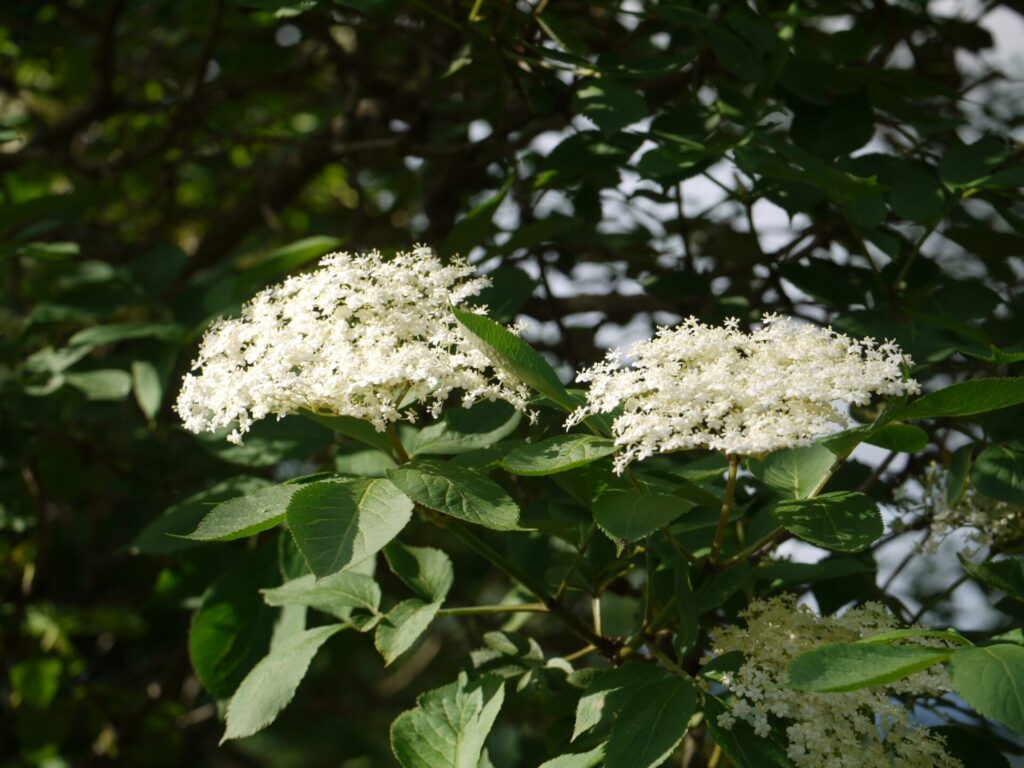Elder
Sambucus nigra L.
Caprifoliaceae
Elder is a small common tree, present throughout Europe with the exception of the Mediterranean zone.
Its genus name, ‘’Sambucus’’ derives from the Greek “Sambyke”, which was a kin dof flute made from the branches of this plant, from which the marrow had been removed.
In France, there are three specis of elder:
- Le sureau yèble, Sambucus ebuluswhich remains herbaceous (without wood at its base). Its flowers are white with red anthers and its black fruits are grouped into upright umbels. Be careful, this elder Is poisonous in all its parts.
- Le sureau à grappe, Sambucus racemosa, with yellow-green flowers and red fruits. It grows mainly in the mountains.
- Le sureau noir, Sambucus nigra, with yellow-green flowers and red fruits. It grows mainly in the mountains.
Our relationship with black elder is very old and rich. Archeological excavations in Switzerland and Italy have established that elderberries were commonly used during the Neolithic era (4500-3000BC), before the use of cereals.
Today, they are still consumed, in jelly or jam, mixed with blackberries for example, to add consistency. Fresh berries are laxative.
Elderberry juice, slowly reduced on low heat, is a traditional treatment for the flu and cough.
The Elder tree has a good reputation in many parts of Europe: protector of pregnant women in Sweden, is known for repelling the evil eye as well as lightnings in Russia and to scare away thieves in Sicily. It is thus still frequently planted for its protective virtues near ancient dwellings and farms.
These pagan traditions received opposition from the Catholic Church, which tried to tarnish the elder’s reputation by making it the tree on which Judas hanged himself, explaining why the fruit umbels curled down towards the floor of shame. This statement is highly unlikely, given the ecology of the tree (rather Nordic), its modest size and the low resistance of its branches…
The flowers are used in herbal medicine as sudorific and febrifuge, against fever, chills and colds. In external use, they have an anti-inflammatory and softening action.
Some umbels can be added to a bath to relieve irritation and itching. Elderflowers are very fragrant and can therefore be used in many preparations: syrup, cream, ice cream, donuts, lemonade (see recipe below).
The green parts of elder, such as bark and leaves, have a strong and unpleasant smell and can cause poisoning (diarrhea and vomiting). They are used in decoctions or purine to fight aphids and flea beetles.
Elders have a strong ecological role: its berries feed more than 20 bird species (starling, tit, thrush…) and its dense foliage and branches provide a breeding ground for birds, while helping to fight crop pests.
Wild bees shelter in its hollow branches. It is definitely a valuable companion for organic farming and an ally in the garden.
Elders still have other promising uses: the stem marrow is a very good insulator, close to cellulose wadding. Its cultivation may soon be able to supply the production of fully ecological and renewable insulation.
Elder lemonade
Place 50 g of pure elderflower in 7 liters of water. Add a sliced lemon.
Leave to rest for 24 hours and filter with a cloth sieve.
Add 1 kg of sugar and the juice of another lemon, mix well and leave to rest for another 24 hours.
Pour into dark glass bottles, close tightly, and keep the bottles in a cool place away from light.
Serve cold after 3 to 4 weeks.
